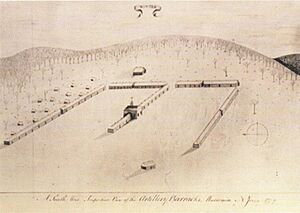Pluckemin Continental Artillery Cantonment Site facts for kids
|
Pluckemin Continental Artillery Cantonment Site
|
|
| Lua error in Module:Location_map at line 420: attempt to index field 'wikibase' (a nil value). | |
| Area | 10.2 acres (4.1 ha) |
|---|---|
| NRHP reference No. | 08000180 |
Quick facts for kids Significant dates |
|
| Added to NRHP | March 14, 2008 |
The Pluckemin Continental Artillery Cantonment Site in Pluckemin, New Jersey, was a really important place during the American Revolutionary War. It was a winter camp for the Continental Army's artillery (their cannons and big guns) during the cold winter of 1778–79. This site was located on the western side of the Second Watchung Mountain.
This place is special because it shows how the military was organized back then. Some people even think it was the very first American military academy. This was 24 years before the famous United States Military Academy at West Point was founded!
Today, the Pluckemin Artillery Cantonment site is not open to the public. There are no buildings or trails. It's mostly an overgrown wooded area. If you want to learn more, you can visit the Vanderveer/Knox House & Museum nearby.
Contents
What Was the Pluckemin Cantonment?
The Pluckemin Cantonment was where the artillery part of the Continental Army stayed during the winter of 1778–79. This was part of a larger camp called the second Middlebrook encampment in Somerset County, New Jersey.
A "cantonment" is a group of buildings built to house soldiers. It's different from a "camp," which is where soldiers might stay in tents. The Pluckemin site was a proper cantonment with buildings.
The site was on a ridge of the First Watchung Mountain. This spot was like a natural fortress. It protected the Continental Army and also overlooked the plains where British forces were stationed. This strong position helped the Continental Army win the war.
The Jacobus Vanderveer house, located close to the cantonment, was the headquarters for General Henry Knox. He was in charge of the Continental Army's artillery. This house is the only building still standing that was connected to the Pluckemin Artillery Cantonment. General Knox stayed there from December 1778 to June 1779.
The land for the cantonment was likely part of a large property owned by Jacobus Vanderveer.
The Pluckemin Academy: Training Soldiers
One of the most exciting things about Pluckemin was the "Academy." General Knox wanted his officers to be well-trained. He hired Christopher Colles to teach them.
In February 1779, General Knox announced that the Academy would open. Officers would learn "Mathematicks" (math) and other important skills. Knox expected them to study hard to become better at their jobs. He believed this training was important for their own reputation and for their country. This early training center is why some call Pluckemin the birthplace of the American military academy.
Other Important Activities at Pluckemin
Besides the Academy, the Pluckemin Cantonment had other important operations:
- Military Store Department: This department managed all the military supplies.
- Laboratory: Here, soldiers repaired and made ammunition.
- Magazine: This was a safe place to store ammunition and gunpowder.
- Hospital: A hospital was set up here during the winter of 1779-1780 to care for sick and injured soldiers.
Discovering the Past: Archeological Projects
People have been studying the Pluckemin site for a long time.
- The First Dig: Henry (Max) Schrabisch, an early New Jersey State Archeologist, started the first "dig" in 1916. He looked for artifacts from the Revolutionary War. Not many records from his work have been found, but local newspapers wrote about it.
- The Pluckemin Archeological Project: In 1979, a new research group started. They worked together to explore the site. John L. Seidel led the main excavations from 1981 to 1989. They used advanced techniques to uncover wide areas and find artifacts.
This project found one of the largest collections of Revolutionary War artifacts in the country! The discoveries showed that after the difficult winter at Valley Forge, the army became much more organized. They built strong barracks (soldier housing) and workshops. Pluckemin became a key place for resupplying the army.
Today, most of the site is owned and protected by Bedminster Township. Work continues on the artifacts found. Experts have even created a "virtual cantonment" – a digital reconstruction of what the camp looked like. You can see an animation of it at the nearby Vanderveer House or on YouTube.
Famous Visitors to Pluckemin
Many important people visited the Pluckemin Cantonment during the Revolutionary War:
- General George Washington
- General Nathanael Greene (who attended a ball there with his wife in February 1779)
- Christopher Colles (the teacher at the Academy)
- Samuel Shaw (an aide to General Knox)
- John Hiwill (who was in charge of music for the army's band)


